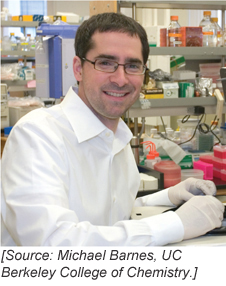Chapter Introduction
6: DNA and RNA Structure
173
MOMENT OF DISCOVERY

When I first started my lab at the Whitehead Institute, my dream was to crystallize the bacterial ribosome and to solve its molecular structure at high resolution. Although a lot had been learned about RNA structure from work on catalytic RNAs and the individual subunits of the ribosome, the possibility of seeing the complete structure of the protein-
Working closely with graduate student Steve Santoso, we eventually got one small perfect-
We figured out how to grow more of those crystals, and eventually we solved the crystal structure of the complete ribosome. Staring in awe at the electron density map, we saw how the RNA helices wove through the molecule like great curving spiral staircases. I felt chills down my spine, realizing I was the first person to see such incredible molecular beauty. This was the culmination of six years of challenging—
—Jamie Cate, on determining the molecular structure of the bacterial ribosome
174
Discovered in the nineteenth century, DNA (deoxyribonucleic acid) would be proposed, by the early twentieth century, as the molecule that stores biological information (see Chapter 2). At that time, however, the way in which the particular properties of its molecular structure could produce traits and behaviors in living organisms was unimaginable. By midcentury, hoping to determine how DNA carried genetic messages that are faithfully transmitted to the next generation when cells divide, researchers in several laboratories had made it their goal to solve the molecular structure of DNA. In 1953, James Watson and Francis Crick, at Cambridge University, used x-



Like DNA, RNA (ribonucleic acid) was first isolated in the nineteenth century from the nuclei of cells. Scientists later recognized that RNA is chemically distinct from DNA, because it contains a different kind of sugar in its nucleotide building blocks (see Chapter 3). As described in Chapter 2, ribosomal RNAs (rRNAs) were found to be components of ribosomes, the complexes that carry out protein synthesis. Messenger RNAs (mRNAs) were known to be intermediaries, carrying genetic information from genes to ribosomes. And transfer RNAs (tRNAs) had been identified as adaptor molecules that translate the information in mRNA into a specific sequence of amino acids. We now know that RNA molecules have many other biological functions as well. For example, they comprise the genomes of certain viruses, such as the human immunodeficiency virus (HIV) and hepatitis C virus (HCV). Some RNA molecules have the ability to work as catalysts—
As we will see, there is no single generic structure of DNA or RNA. Rather, there are numerous variations on a common structural theme, resulting from the chemical and physical properties of the polynucleotide chain. Indeed, the structural stability of DNA and the structural diversity of RNA explain why these molecules have evolved to function in all aspects of maintaining and transmitting biological information. In this chapter, we first explore the general properties of nucleotides, then turn to the structures of DNA and RNA. We conclude by looking at the chemical behavior of nucleic acids under biological conditions.